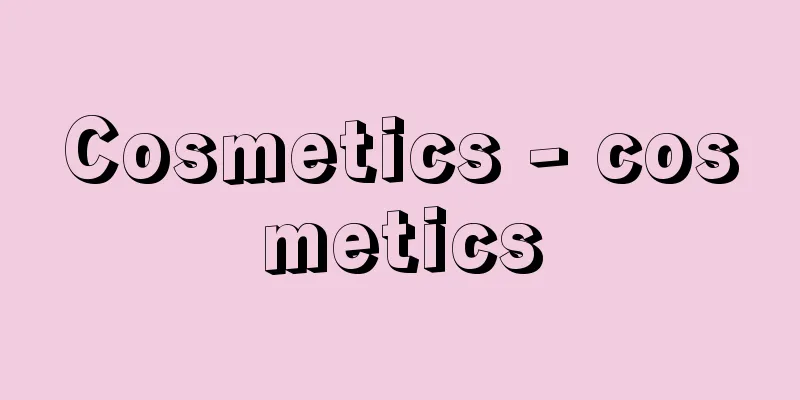Cosmetics - cosmetics

|
The Pharmaceutical Affairs Law defines cosmetics as "substances that are intended to be applied by rubbing, spraying or similar means to the body in order to cleanse, beautify or increase the attractiveness of the human body, change appearance or keep skin or hair healthy, and that have a mild effect on the human body." The raw materials used are also regulated in detail from production to labeling, sales and advertising, through the administration of consumer protection, including "Standards for Cosmetic Raw Materials" and "Raw materials designated by the Minister of Health, Labor and Welfare," as well as "Standards for Safety" and "Fair Competition Codes for Cosmetic Labeling." Manufacturers also conduct tireless research, and each manufacturer implements their own quality control that is even stricter than these regulations, placing even more emphasis on safety. [Fumisako Yokota] historyConsidering the fact that a paste incense bottle from around the 3rd century BC is in the possession of the British Museum, it can be said that cosmetics have been around in Europe for quite some time. It is said that people not only used incense but also used paint to decorate their faces; they would paint their eyelids, eyelashes and eyebrows black with kohl, make their cheeks red with rouge, and dye their nails red with henna. These practices continued into the Greek and Roman era. Poppaea Sabina, wife of the Roman Emperor Nero, is said to have invented a way to keep her skin white and soft using a face pack-like cosmetic made from bread and donkey's milk. This was popular in medieval Italy, but after the Italian Wars in the early 16th century, it was introduced to France and spread among the aristocracy. In the 17th century, as the living rooms of noble families' mansions became salons, people began to prefer paler skin instead of tanned skin, and in Rome, people painted their skin white with white chalk or white lead, and used vegetable dye lipstick. In addition to perfumes and perfumed oils, there was also pharos paint (made from crocodile innards) to remove freckles. In ancient China, washing powder made from beans was used for washing hair, and a type of makeup called gakuo (forehead yellow) was applied to the hairline of the forehead. It is said that the raw material for this was yellow earth or wolf droppings. Eyebrows were shaved and then drawn thin, so eyebrow ink was also blue and made from indigo. These were already seen during the Western Han Dynasty around the 1st century BC. Also used were face powder made from lead, blusher made from crimson indigo, lipstick, makeup with red around the eyes, and false moles. Then, during the Tang Dynasty, from the 7th to the 10th centuries, as exchanges with the so-called Western Regions became more active, makeup reached its heyday and the trend for heavy, glossy makeup increased. In all cases, the raw materials for cosmetics were mainly vegetable or mineral, and this continued into later times. Since the Meiji period, Japanese customs have been Westernized, and cosmetics have also become Western-style, and today they have developed to rival those of Western Europe. Tracing its origins, Japan introduced manufacturing methods from China and Korea around the Nara period, and was influenced by the Nanban and red-haired culture from the Momoyama period onwards, but it also created uniquely Japanese products. In the Edo period, face powder, rouge, lotion, hair oil, gallnut powder (one of the ingredients in blackening teeth), and fragrant wood were all sold at cosmetics stores and haberdashery shops. In addition, cosmetics included rice bran bags, loofah water, yusuru (rice water for combing hair), hair washing products (funori and udon flour), washing powder (red azuki bean powder, etc.), beauty pigments (such as Japanese bush warbler droppings), and iron oxide water (one of the ingredients for blackening teeth), most of which they made at home. The oldest cosmetics manufacturer still in business today is Yanagiya, founded as Beniya in 1615 (Genwa 1). That year, Roikkan, a Chinese medicine doctor from the Ming Dynasty, produced rouge, and the first Yanagiya Gorosaburo succeeded him. In 1878 (Meiji 11), Komachisui was released, and in 1917 (Taisho 6), Shiseido released Nanairo Kona Oshiroi, the first colored powder, in addition to the previously only available white and pale pink powders. In terms of popularizing cosmetics, Europe, China, and Japan all had to wait for advances in science and technology. From the end of the 19th century to the beginning of the 20th century, the influence of developments in the dye and pharmaceutical industries, and particularly the chemical industry, made it possible to mass-produce the raw materials needed to make cosmetics at low cost. Advances in medicine also helped popularize cosmetics. After two world wars, women's social advancement has increased dramatically compared to previous eras, and beauty habits have grown accordingly, with cosmetics even becoming a part of daily necessities. They have expanded from basic cosmetics to makeup cosmetics, and now cosmetics are made for each part of the body, from the hair to the soles of the feet. [Fumisako Yokota] Classification(1) Basic cosmetics: Products used primarily for skin care, such as cosmetic soap, lotion, milky lotion, cream, and face masks. (2) Makeup cosmetics Also called finishing cosmetics, these are products that are applied to the face, body, nails, etc. to add color, change the skin color, add shadows to create a three-dimensional effect, emphasize certain parts of the body color to change the appearance, cover up noticeable areas such as blemishes and freckles, and so on, with the aim of beautifying both the body and mind. These include face powder, foundation, lipstick, blusher, eye makeup cosmetics (eyeliner, eye shadow, mascara, eyebrow ink), nail polish, and covering foundation. (3) Fragrance products: Products that contain fragrance. With the development of science and technology, fragrances that have been used in various forms since ancient times are now being mass-produced economically in new ways. Perfume (including paste fragrance) is the main source of fragrance, and similar products such as eau de cologne (parfum de toilette, eau de toilette, eau de cologne) are widely used. Products that also have functions other than fragrance include body lotions, body powders, and soaps. (4) Hair cosmetics There are a wide variety of products, including shampoos for removing dirt from hair, finishing agents, and even non-medicinal hair products. Some products may serve more than one purpose. Soap and shampoo for cleaning. Hair rinses, hair conditioners, and hair creams for conditioning. Oil-based hair styling agents (pomades, hair creams) and non-oily hair styling agents (hair liquids, setting lotions, hair sprays) for styling. Hair creams, hair treatments, and hair tonics for nourishing hair. Anti-dandruff shampoos for removing dandruff. Setting lotions for adding waves (temporary) and permanent wave agents (long-term). Color rinses, color creams, color chalks, and color sprays for changing color (all temporary), hair dyes, and hair removers (long-term). The most common aerosol product for hair (a product in which the contents of a sealed container are expelled under some kind of pressure into a mist, foam, paste, or powder form) is hairspray, but other products include hair conditioners, shampoos, rinses, and hair colorants. (5) Men's cosmetics Male hormones activate the sebaceous glands, while female hormones suppress them. Cosmetics are divided into men's and women's products based on the difference in how they affect the skin. Therefore, men's cosmetics tend to be relatively refreshing and are designed to suppress the growth of bacteria and protect the skin. In particular, the way fragrances are applied is different from women's cosmetics. Facial cosmetics include shaving cream, after lotion, skin milk, and skin cream, while hair cosmetics include shampoo, conditioner, hair liquid, hair cream, pomade, mascara, and hairspray. Fragrance products include eau de cologne and eau de toilette. (6) Medicinal cosmetics (quasi-drugs) In addition to medicines and cosmetics, quasi-drugs are classified under Article 2, paragraph 2 of the Pharmaceutical Affairs Law. They are defined as "substances that have a mild effect on the human body," and are not called medicinal cosmetics under the Pharmaceutical Affairs Law. Unlike Europe and America, quasi-drugs in Japan are not intended for "treatment," but rather for "prevention." Examples include hair dyes, hair removers, perm agents, deodorants, bleaching creams, sunscreen creams, and bath additives, and cannot be used for any other purpose. When using these products, it is important to read the "Cautions for Use" on the product and use them correctly. [Fumisako Yokota] Usage notesWhen applying makeup, you need to correct imperfections according to your face shape, each part of your body, and the condition of your skin, and make the most of your individuality. Whether or not a cosmetic product suits your skin has different meanings depending on the person using it. Most of the so-called makeup rashes are caused by something that comes into contact with the surface of the skin, causing irritation and inflammation, and are therefore called contact dermatitis. (1) If you experience skin irritation after using new cosmetics, first remove all of the makeup and allow the skin to cool thoroughly. It is not good to be nervous and use medicated soaps or other products that cause strong irritation. (2) If the skin becomes severely inflamed or swollen, or if blisters form, seek medical attention from a dermatologist as this may leave a scar. (3) Stop using all cosmetics until the rash is completely healed. A patch test is a simple way to check whether a cosmetic product is suitable for you. The test involves applying the product to the skin and observing the skin's reaction 24 and 48 hours later. The test is usually done on a soft area of skin, such as the inside of the upper arm. [Fumisako Yokota] "Chronology of Documents on the History of Cosmetics" (1979, Pola Cultural Research Institute) "History of Beauty" by Jacques Pensée and Yvingle Delandre, translated by Noriko Aoyama (Hakusuisha, Que Saij) [Reference items] | | | | | | | | | | | | | | | | | | | |Source: Shogakukan Encyclopedia Nipponica About Encyclopedia Nipponica Information | Legend |
|
薬事法では、「人の身体を清潔にし、美化し、魅力を増し、容貌(ようぼう)を変え、又は皮膚若(も)しくは毛髪をすこやかに保つために、身体に塗擦、散布その他これらに類似する方法で使用されることが目的とされている物で、人体に対する作用が緩和なもの」と定義している。使用する原料も「化粧品原料基準」「厚生労働大臣が指定する原料」などとともに、「安全性に関する基準」や「化粧品の表示に関する公正競争規約」など、製造から表示事項や販売、広告に至るまで、事細かく規制され、消費者保護行政がなされている。メーカー側もたゆまぬ研究を重ね、それらの規約よりさらに厳しい各メーカー独自の品質管理を実施し、より安全性を重視している。 [横田富佐子] 歴史紀元前3世紀ごろの練り香入れが、大英博物館に所蔵されている事実から、化粧品はヨーロッパでもかなり古くからあったといえよう。香ばかりでなく、ペイントを使って顔を彩っていたともいわれ、コールとよばれるアンチモンなどの眉墨(まゆずみ)で、瞼(まぶた)やまつ毛、眉毛を黒く塗り、紅でほおを赤くし、ヘンナで爪(つめ)も赤く染めていたという。これらはギリシア・ローマ時代まで伝えられた。ローマ皇帝ネロの后ポッパエア・サビナは、パンとロバの乳でつくったパックのような化粧品を使って、肌を白く柔らかく保つ方法を考案したといわれる。これは中世のイタリアなどでは盛んであったが、16世紀前半のイタリア戦争以降フランスに渡って、貴族の間にも広まった。 17世紀に入って貴族の館(やかた)の居間がサロン化したため、肌の色も日焼け肌から色白が好まれるようになって、ローマでは、白いチョークか鉛白で肌を白く塗り、植物性染料の口紅を使った。香水、香油のほか、そばかすを消すファロスのうわ塗り(ワニの内臓でつくったもの)などもあった。 中国でも古代から洗髪のための、豆を原料としてつくった洗い粉が使われていたり、額黄(がくおう)といって、額の生え際に黄粉をつける化粧が行われていたりした。その原料は黄土ともオオカミの糞(ふん)であったともいわれている。眉を剃(そ)り落として細く眉を描くため、眉墨は青色もあり、インジゴが原料であった。これらは前1世紀ごろの前漢の時代にすでにみられた。また鉛から製したおしろいや、紅藍(こうらん)を原料とした頬紅(ほおべに)、口紅、目の縁に紅をさす化粧などや付けぼくろも使われていた。そして唐の時代、7世紀から10世紀ごろまでに、いわゆる西域(せいいき)との交流が盛んになるにつれて、化粧の全盛時代を迎え、濃艶(のうえん)な厚化粧の傾向を増した。いずれも化粧品の原料は、植物性のものや鉱物性のものが主であって、それが後の時代まで続いた。 日本では明治時代以降、風俗が西欧化への道をたどり、化粧品も洋風になって、現在では西欧に劣らない発展をみせている。その源流をたどると、奈良時代あたりは中国や朝鮮から製法を導入したり、桃山時代以降は南蛮、紅毛文化の影響を受けたりもしたが、そのなかで日本独自のものを生み出してもいる。江戸時代に入ると、おしろい、紅、化粧水、髪油、五倍子粉(ふしのこ)(お歯黒の原料の一つ)、香木などがあり、化粧品屋や小間物屋で売っていた。また、化粧料としては、糠袋(ぬかぶくろ)、ヘチマ水、泔(ゆする)(お米のとぎ汁。髪を梳(す)くためのもの)、洗髪料(フノリとうどん粉)、洗い粉(赤小豆(あずき)の粉など)、美顔料(ウグイスの糞など)、鉄漿水(かねみず)(お歯黒原料の一つ)などで、ほとんどを自分の家でつくっていた。 現在まで続いている化粧品メーカーのうちもっとも古いのは、1615年(元和1)紅屋として創業した柳屋である。その年、明(みん)国人の漢方医の呂一官(ろいっかん)が紅を製造し、初代柳屋五郎三郎がその跡を継いだ。1878年(明治11)に「小町水(こまちすい)」が発売され、1917年(大正6)には、それまで白色と薄紅入りしかなかったおしろいのほかに、資生堂が有色おしろいの初めとして、七色粉白粉(なないろこなおしろい)を発売した。 化粧品の大衆化という意味では、ヨーロッパ、中国、日本においても、おしなべて科学技術の進歩をまたなければならなかった。19世紀の終わりから20世紀初頭にかけて、染料、製薬工業の発達の影響を受け、とくに化学工業が一段と進歩したことにより、化粧品の製造に必要な原料が大量に安価に製造されるようになった。また医学の進歩も化粧品の普及に力を貸した。 二度の世界大戦を経たことで、女性の社会的進出は、その前の時代と比べて飛躍的に増大し、美容の習慣はそれにつれて伸び、化粧品は生活必需品の一部にさえなりつつある。そして基礎化粧品からメーキャップ化粧品まで広がり、いまや頭髪から足の先に至るまで、それぞれに対応する化粧品がつくられている。 [横田富佐子] 分類(1)基礎化粧品 主としてスキンケアに用いられるもので、化粧せっけん、化粧水、乳液、クリーム、パックなど。 (2)メーキャップ化粧品 仕上げ化粧品ともいい、顔や体や爪などに塗布して色彩を施し、肌色を変えたり、陰影をつけて立体感を出したり、一部分を色彩的に強調して容貌を変えたり、しみやそばかすなど目だちやすい部分を覆い隠すなどして、心身ともに美化させる目的のものをいう。おしろい、ファンデーション、口紅、頬紅、アイメーキャップ化粧料(アイライナー、アイシャドー、マスカラ、眉墨)、美爪(びそう)料、カバー用ファンデーションなど。 (3)フレグランスfragrance製品 芳香を含む製品をいう。科学技術の発展により、古来からさまざまな形で使われてきた香料が、新しく経済的に量産されている。香りの中心になるものは香水(練り香も含む)で、同類としてオーデコロン類(パルファン・ド・トアレ、オー・ド・トアレ、オーデコロン)が多く使われている。香り以外の機能ももたせるものとしては、ボディーローション、ボディーパウダー、せっけんなどがある。 (4)毛髪用化粧品 頭髪の汚れを除去するためのシャンプー剤から仕上げ剤、さらに頭髪用医薬部外品を含めると、多種多様なものがある。製品によっては二つ以上の目的を兼ねる場合もある。洗浄のためのせっけん、シャンプー。調整のためのヘアリンス剤、ヘアコンディショナー、ヘアクリーム。整髪のための油性整髪剤(ポマード、ヘアクリーム)、非油性整髪剤(ヘアリキッド、セットローション、ヘアスプレー)。養毛のためのヘアクリーム、ヘアトリートメント、ヘアトニック。ふけをとるふけとりシャンプー。ウエーブをつけるセットローション(一時的)、パーマネント・ウエーブ剤(長期的)。色を変えるカラーリンス、カラークリーム、カラーチョーク、カラースプレー(以上一時的)、染毛剤、脱毛剤(長期的)。毛髪用エアゾール製品(密閉容器中に封入された内容物がなんらかの圧力によって霧状、泡状、ペースト状、粉状に吐出されるもの)は、ヘアスプレーがもっとも一般的であるが、ほかにヘアコンディショナー、シャンプー、リンス、ヘアカラーなどもある。 (5)男性用化粧品 男性ホルモンは皮脂腺(せん)の働きを活発化し、女性ホルモンは抑制するという。皮膚の働きの違いによって、男性用、女性用と分けられている。したがって男性用化粧品は比較的さっぱりした感じのものが多く、雑菌の増殖を抑え、肌の保護を目的につくられている。とくに香りのつけ方が女性用と違う。顔用化粧品としては、シェービングクリーム、アフターローション、スキンミルク、スキンクリームなどがあり、頭髪用化粧品としては、シャンプー、リンス、ヘアリキッド、ヘアクリーム、ポマード、チック、ヘアスプレーなど。フレグランス製品はオーデコロン、オー・ド・トアレなどが多い。 (6)薬用化粧品(医薬部外品)薬事法第2条第2項に、医薬品や化粧品とは別に分けて医薬部外品がある。「人体に対する作用が緩和な物」と定められており、薬事法上は薬用化粧品という呼称はない。ヨーロッパやアメリカと異なり、わが国の医薬部外品は「治療」を目的とするものではなく、「防止を目的とするもの」である。たとえば染毛剤、脱毛剤、パーマ剤、防臭剤、漂白クリーム、日焼け止めクリーム、浴用剤などがあり、その目的以外には使えない。なお使用にあたっては、製品に記載されている「使用上の注意」をかならず読んで、正しく使うことがだいじである。 [横田富佐子] 使用上の注意化粧をするにあたっては、顔かたち、各部位、皮膚の状態などに応じて欠点を補正し、個性を生かし、引き出すように行わなければならない。使用する化粧品が、肌にあう・あわないは、それぞれ使用する人によって意味合いが違ってくる。いわゆる化粧かぶれは、肌の表面に触れたものが刺激になって炎症をおこすことから、接触皮膚炎とよばれるものが多い。 (1)新しい化粧品を使用して、もし肌に炎症を生じたときには、まずいっさいの化粧を落として、皮膚を十分に冷やす。神経質になって、薬用せっけんなどを用いて強い刺激を与えることはよくない。 (2)肌の炎症や腫(は)れがひどかったり、水ぶくれのできたりしたときには、跡を残すことがあるので、皮膚科医の手当てを受ける。 (3)かぶれが完治するまでは、いっさいの化粧品の使用をやめる。 使用する化粧品の適・不適を調べる簡単な方法として、パッチテストがある。化粧品を肌につけて、24時間後と48時間後に皮膚にどのような反応が現れるかをみる方法で、部位としては上膊(じょうはく)部の内側など、柔らかい皮膚を使って行う。 [横田富佐子] 『『化粧史文献資料年表』(1979・ポーラ文化研究所)』▽『ジャック・パンセ、イヴィンヌ・デランドル著、青山典子訳『美容の歴史』(白水社・文庫クセジュ)』 [参照項目] | | | | | | | | | | | | | | | | | | | |出典 小学館 日本大百科全書(ニッポニカ)日本大百科全書(ニッポニカ)について 情報 | 凡例 |
<<: Chosenia arbutifolia (Cosmetic willow)
>>: Toilet soap (English spelling)
Recommend
Perrier, C. (English spelling) PerrierC
…Periodic table Element symbol = Tc Atomic number...
Market flag - Ichibaki
…Until the end of the 12th century, 90% of charte...
Oligochaeta
...A general term for annelids in the Oligochaeta...
Mercator's projection
…His real name was Gerhard Kremer, and Mercator w...
Shiobara [town] - Shiobara
An old town in Nasu County, northern Tochigi Prefe...
Quantum fluid
…There is actually a more familiar example: the e...
Australian National University - Australian National University
A national, coeducational university in Canberra, ...
White Lotus Sect - Byakurenkyo
A Chinese religious organization. It began as a r...
Sept-Îles (English spelling)
…Canada's largest iron ore producer, operatin...
Hironori Iyoshi - The child of life
Year of birth: Unknown An official from the late 7...
Flower Garland - Keman
It is one of the ornaments used for decoration in...
Woodpecker Finch - Woodpecker Finch
…The Warbler Finch, Certhidea olivacea , feeds on...
Nohara House
This manor was located in the northwest of Tamana ...
Sata clan - Satauji
A powerful clan based in Minamimata, Nejimein, Osu...
Ganjam - Ganjam
...But it was later invaded by the Chola dynasty,...









